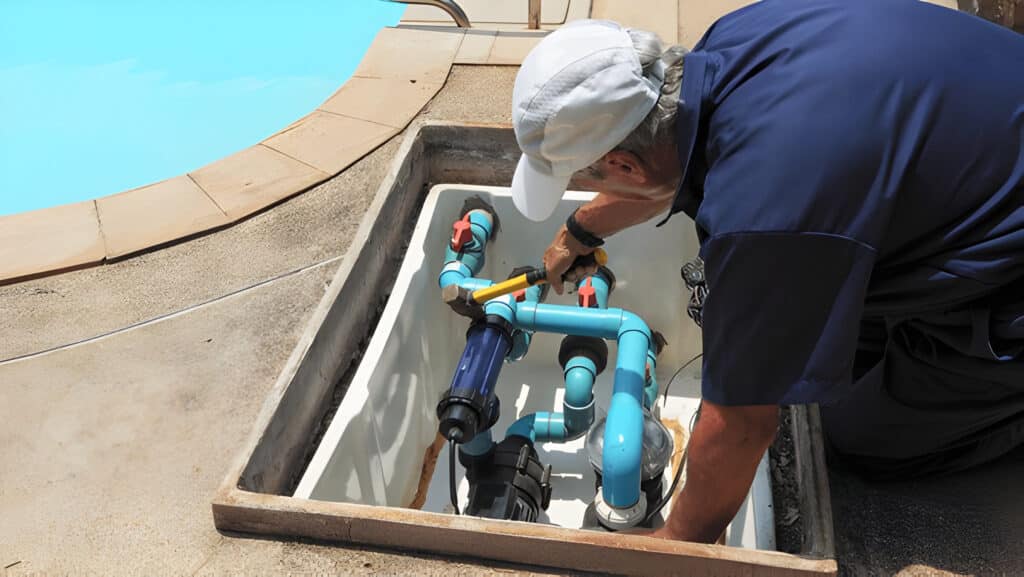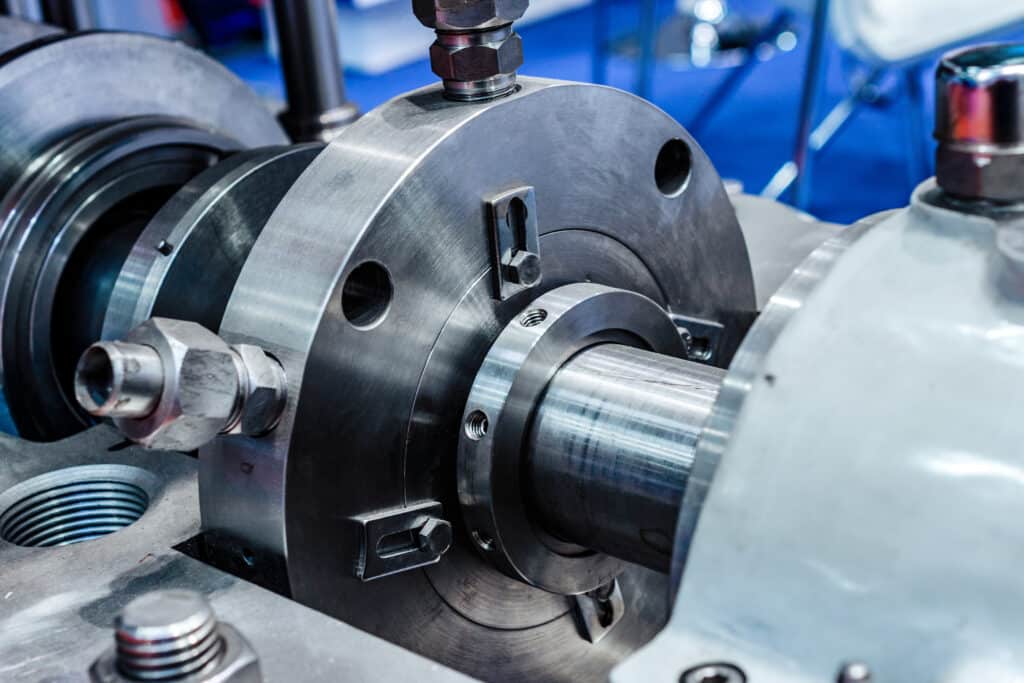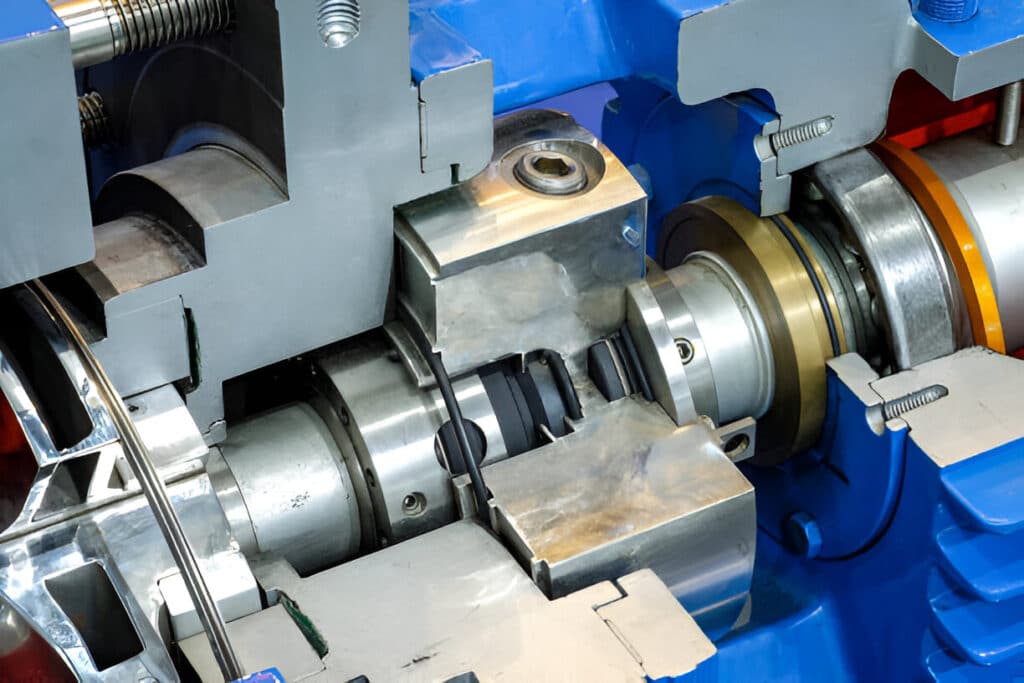
Step 1. Check the Water Level
Ensure that the water level in your pool is at the proper height, typically halfway up the skimmer basket.
If the water level is too low, add water to the pool until it reaches the appropriate level.
Step 2. Inspect the Pump Lid and O-Ring
Check the pump lid for cracks or damage that could allow air to enter the system. Also, inspect the lid o-ring for signs of wear, such as cracks, dryness, or misalignment.
Replace the o-ring if necessary and ensure it is properly seated before securing the pump lid.
Step 3. Clear Any Blockages
Examine the skimmer basket, pump basket, and impeller for debris that could obstruct water flow. Remove any leaves, twigs, or foreign objects found in these areas.
Step 4. Locate and Fix Air Leaks
Inspect the suction side of the pump, including the pipe connections and valve o-rings, for air leaks. Tighten any loose connections and replace damaged o-rings or gaskets.
Step 5. Adjust Diverter Valve Settings
If your pool has a diverter valve, ensure it is set to the correct position for normal operation. An incorrectly positioned diverter valve can restrict water flow to the pump, making it difficult to achieve prime.
Step 6. Prime the Pump
First, turn off the power to the unit. Remove the pump lid and fill the basket with water. Replace the lid, ensuring it is properly sealed. Turn the power back on and allow the pump to run for a few minutes.
Common Causes of Priming Problems
Water Level Is Too Low
A low water level in the pool can prevent the pump from drawing in enough water to achieve prime.
Weir Gates Are Stuck
Weir gates are designed to control water flow into the skimmer basket. If they become stuck in the open position, air can enter the system, causing priming issues. Inspect the weir gates and ensure they are moving freely.
The Cover O-Ring Is Missing or Damaged
A missing or damaged cover o-ring can allow air to enter the pump, preventing proper priming. Inspect the o-ring for signs of wear and replace it if necessary.
Pump Basket Needs Replacement or Adjustment
A cracked or improperly seated pump basket can lead to priming failures. Replace the basket if it is damaged, and ensure it is correctly positioned within the pump housing.
Bad Motor
A faulty pump motor can hinder the priming process. If the motor is not functioning properly, it may need to be repaired or replaced by a professional.
Bad Intermatic Timer
An issue with the pump’s timer can cause intermittent priming problems. Check the timer settings and replace the timer if it is malfunctioning.
Bad Automation
Faulty automation systems can lead to priming issues by sending incorrect signals to the pump. Have the automation system inspected and repaired by a qualified technician.
Pump Housing Is Cracked
A cracked pump housing can allow air to enter the system, causing priming difficulties. Inspect the housing for cracks and replace it if necessary.
Suction Side Leak
Air leaks on the suction side of the pump can prevent proper priming. Check for leaks in the pipe connections, valves, and o-rings, and repair as needed.
Pool Pump Is Old
As pool pumps age, they become more susceptible to priming issues due to wear and tear on components like seals and impellers. Consider replacing an old pump with a new, more efficient model.
Improperly Sized or Installed Pump
An incorrectly sized or installed pump can lead to priming problems. Ensure the pump is properly matched to your pool’s size and requirements, and that it is installed according to the manufacturer’s specifications.
Worn out Pump Seals, Impeller, Or Diffuser
Worn pump seals, impellers, or diffusers can allow air to enter the system, causing priming issues. Inspect these components for signs of wear and replace them if necessary.
Underground Pipe Leaks or Damage
Leaks or damage to underground pipes can introduce air into the system, hindering the pump’s ability to prime. Locate and repair any leaks or damage to restore proper water flow.
Pump Speed Set Too Low
If you have a variable speed pump, ensure it is set to the correct speed for optimal performance. A pump speed that is too low can result in priming difficulties.
Faqs
What Does Priming Failure Mean on Pool Pump
Priming failure occurs when a pool pump is unable to draw water from the pool and establish a steady flow. This can be caused by various factors, such as air leaks, low water levels, or blockages in the suction line.
How Do I Know if My Pool Pump Needs Primed
Signs that your pool pump needs to be primed include:
- The pump is running but not circulating water
- Bubbles appear in the pump basket or return lines
- The pump makes unusual noises, such as whining or humming
- The pressure gauge reads lower than normal
Pool Pump Losing Prime When Turned off
If your pool pump loses prime when turned off, it may indicate an issue with the check valve or foot valve, which are designed to hold water in the suction line. Inspect these valves for proper operation and replace them if necessary.
How to Prime a Pool Pump with Sand Filter
To prime a pool pump with a sand filter:
- Turn off the pump and close the valves on the suction and return lines.
- Remove the pump lid and fill the basket with water.
- Replace the lid, ensuring it is properly sealed.
- Open the valves and turn on the pump.
- Monitor the pressure gauge and water flow for proper operation.
Pool Pump Running but Not Pumping Water
If your pool pump is running but not pumping water, it may be experiencing priming issues. Follow the step-by-step guide provided earlier to troubleshoot and resolve the problem.
How to Prime a Pool Pump That Is Higher Than the Pool
Priming a pool pump that is higher than the pool can be challenging due to the increased suction lift. To prime the pump, follow these steps:
- Close the valves on the suction and return lines.
- Remove the pump lid and fill the basket with water.
- Replace the lid and ensure it is properly sealed.
- Slowly open the suction valve, allowing water to fill the suction line.
- Once water reaches the pump, open the return valve and turn on the pump.
Inground Pool Pump Priming Failure
Inground pool pumps can experience priming failures due to the same issues as above-ground pumps, such as low water levels, air leaks, or blockages. Follow the troubleshooting steps provided earlier to identify and resolve the problem.
Above Ground Pool Pump Priming Failure
Above-ground pool pumps can encounter priming failures due to issues like air leaks in the suction line, clogged skimmer baskets, or damaged pump components. Use the step-by-step guide provided to diagnose and fix the issue.





